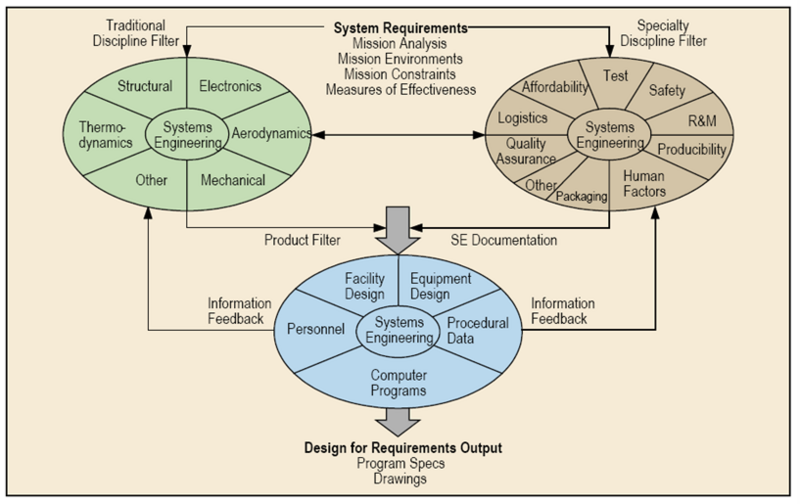Difference between revisions of "Systems Engineering and Quality Attributes"
(→Topics) |
|||
| Line 5: | Line 5: | ||
*[[Reliability, Availability, and Maintainability]] | *[[Reliability, Availability, and Maintainability]] | ||
*[[Human Systems Integration]] | *[[Human Systems Integration]] | ||
| − | *[[Safety Engineering]] | + | *[[System Safety Engineering]] |
*[[Security Engineering]] | *[[Security Engineering]] | ||
*[[Electromagnetic Interference/Electromagnetic Compatibility]] | *[[Electromagnetic Interference/Electromagnetic Compatibility]] | ||
Revision as of 15:21, 3 February 2017
Specialty engineering disciplines support product, service and enterprise development by applying crosscutting knowledge to system design decisions, balancing total system performance and affordability. This knowledge area presents several of the supporting engineering disciplines with a focus on the systems engineer.
Topics
Each part of the SEBoK is divided into knowledge areas (KAs), which are groupings of information with a related theme. The KAs in turn are divided into topics. This KA contains the following topics:
- Reliability, Availability, and Maintainability
- Human Systems Integration
- System Safety Engineering
- Security Engineering
- Electromagnetic Interference/Electromagnetic Compatibility
- Resilience Engineering
- Manufacturability and Producibility
- Affordability
- Environmental Engineering
- Logistics Engineering
Specialty Requirements
The systems engineering team must ensure that specialty requirements are properly reviewed with regard to their impact on life cycle costs, development schedule, technical performance, and operational utility. For example, security requirements can impact operator workstations, electromagnetic interference requirements can impact the signal in the interfaces between subsystems, and mass-volume requirements may preclude the use of certain materials to reduce subsystem weight.
Engineering specialists audit the evolving design and resulting configuration items to ensure that the overall system performance also satisfies the specialty requirements. Including appropriate specialty engineers within each systems engineering team assures that all system requirements are identified and balanced throughout the development cycle.
Integration of Specialty Engineering
Integration of engineering specialties into a project or program is, or should be, a major objective of systems engineering management. With properly implemented procedures, the rigor of the systems engineering process ensures participation of the specialty disciplines at key points in the technical decision making process. Special emphasis on integration is mandatory because a given design could in fact be accomplished without consideration of these “specialty” disciplines, leading to the possibility of system ineffectiveness or failure when an unexamined situation occurs in the operational environment.
For example, human factors considerations can contribute to reduced workloads and therefore lower error rates by operators in aircraft cockpits, at air-traffic consoles, or nuclear reactor stations. Similarly, mean-time-to-repair features can significantly increase overall system availability in challenging physical environments, such as mid-ocean or outer space. Specialty engineering requirements are often manifest as constraints on the overall system design space. The role of system engineering is to balance these constraints with other functionality in order to harmonize total system performance. The end goal is to produce a system that provides utility and effectiveness to the customer at an affordable price.
As depicted in Figure 1, systems engineering plays a leadership role in integrating traditional disciplines, specialty disciplines, and unique system product demands to define the system design. Relationships for this integration process are represented as interactions among three filters.
The first filter is a conceptual analysis that leverages traditional design consideration (structural, electronics, aerodynamics, mechanical, thermodynamics, and other). The second filter evaluates the conceptual approach using specialty disciplines, such as safety, affordability, quality assurance, human factors, reliability and maintainability, producibility, packaging, test, logistics, and others, to further requirements development. Design alternatives that pass through these two processes go through a third filter that incorporates facility design, equipment design, procedural data, computer programs, and personnel to develop the final requirements for design selection and further detailed development.
References
Works Cited
USAF. 2000. Guidelines for Successful Acquisition and Management of Software-Intensive Systems: Weapon Systems Command and Control Systems Management Information Systems, version 3.0. Hill AFB: Department of the Air Force Software Technology Support Center. May 2000. Accessed on September 11, 2011. Available at http://www.stsc.hill.af.mil/resources/tech%5Fdocs/.
Primary References
USAF. 2000. Guidelines for Successful Acquisition and Management of Software-Intensive Systems: Weapon Systems Command and Control Systems Management Information Systems, version 3.0. Hill AFB: Department of the Air Force Software Technology Support Center. May 2000. Accessed on September 11, 2011. Available at http://www.stsc.hill.af.mil/resources/tech%5Fdocs/.
Additional References
None.
SEBoK Discussion
Please provide your comments and feedback on the SEBoK below. You will need to log in to DISQUS using an existing account (e.g. Yahoo, Google, Facebook, Twitter, etc.) or create a DISQUS account. Simply type your comment in the text field below and DISQUS will guide you through the login or registration steps. Feedback will be archived and used for future updates to the SEBoK. If you provided a comment that is no longer listed, that comment has been adjudicated. You can view adjudication for comments submitted prior to SEBoK v. 1.0 at SEBoK Review and Adjudication. Later comments are addressed and changes are summarized in the Letter from the Editor and Acknowledgements and Release History.
If you would like to provide edits on this article, recommend new content, or make comments on the SEBoK as a whole, please see the SEBoK Sandbox.
blog comments powered by Disqus